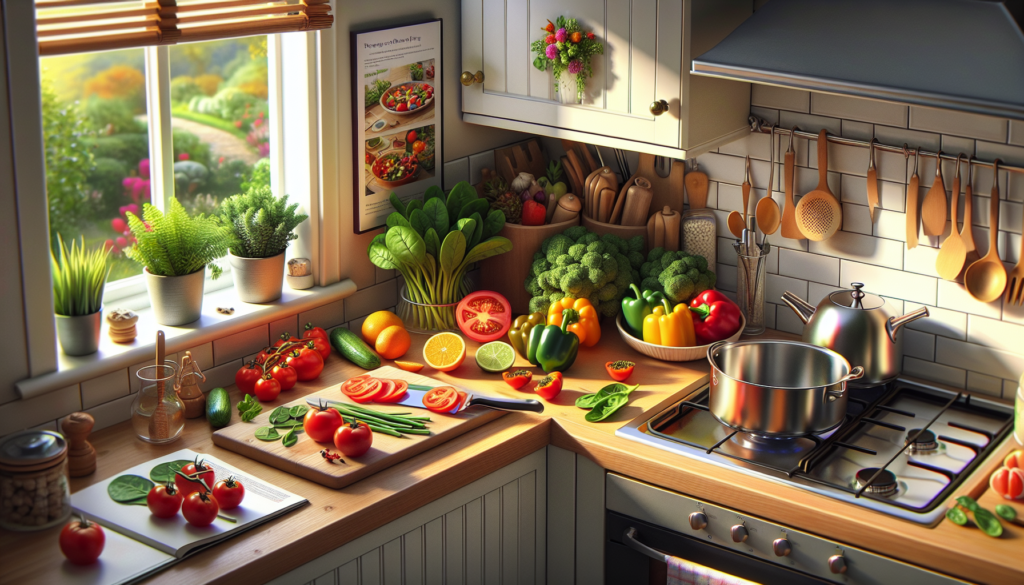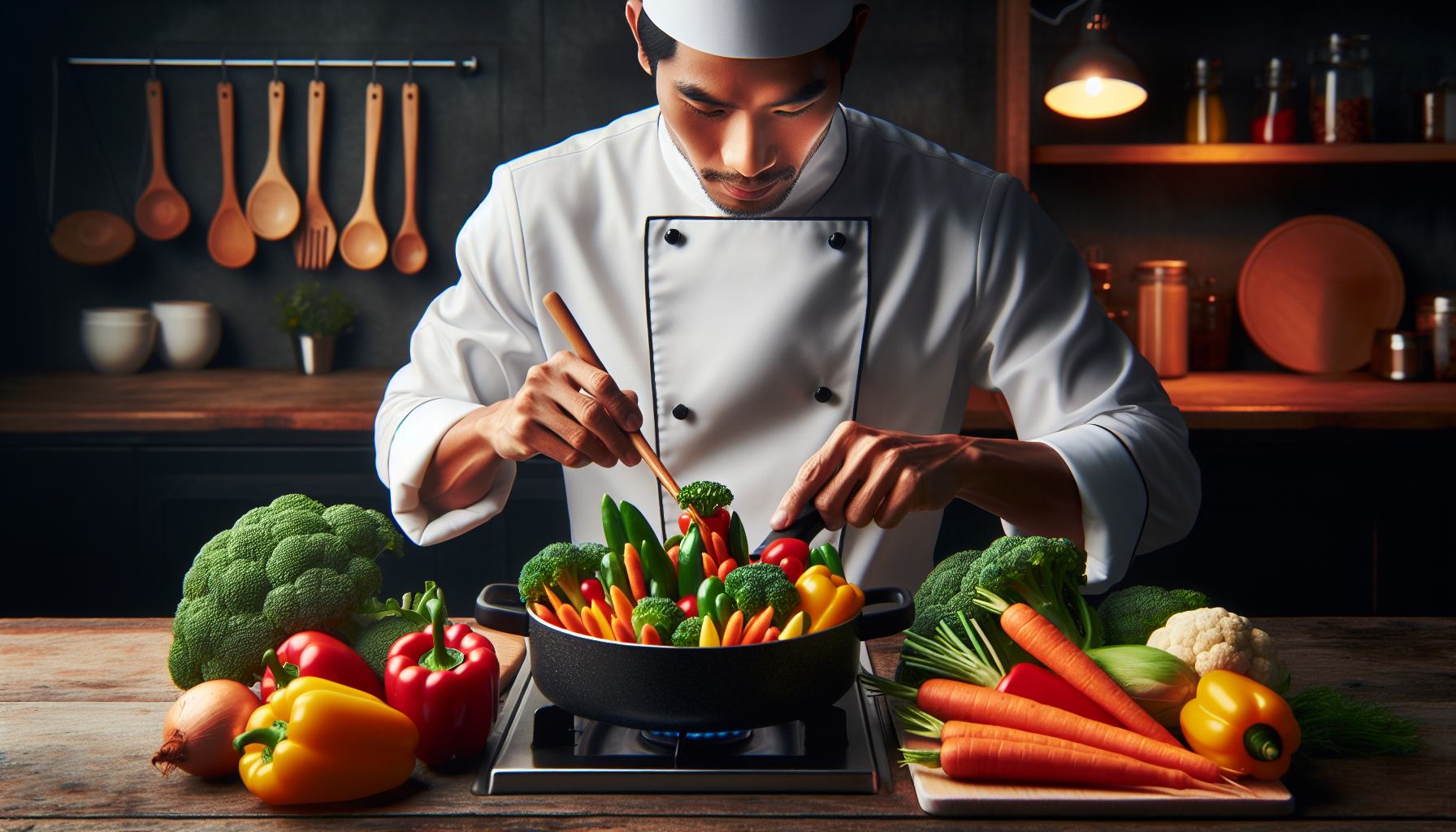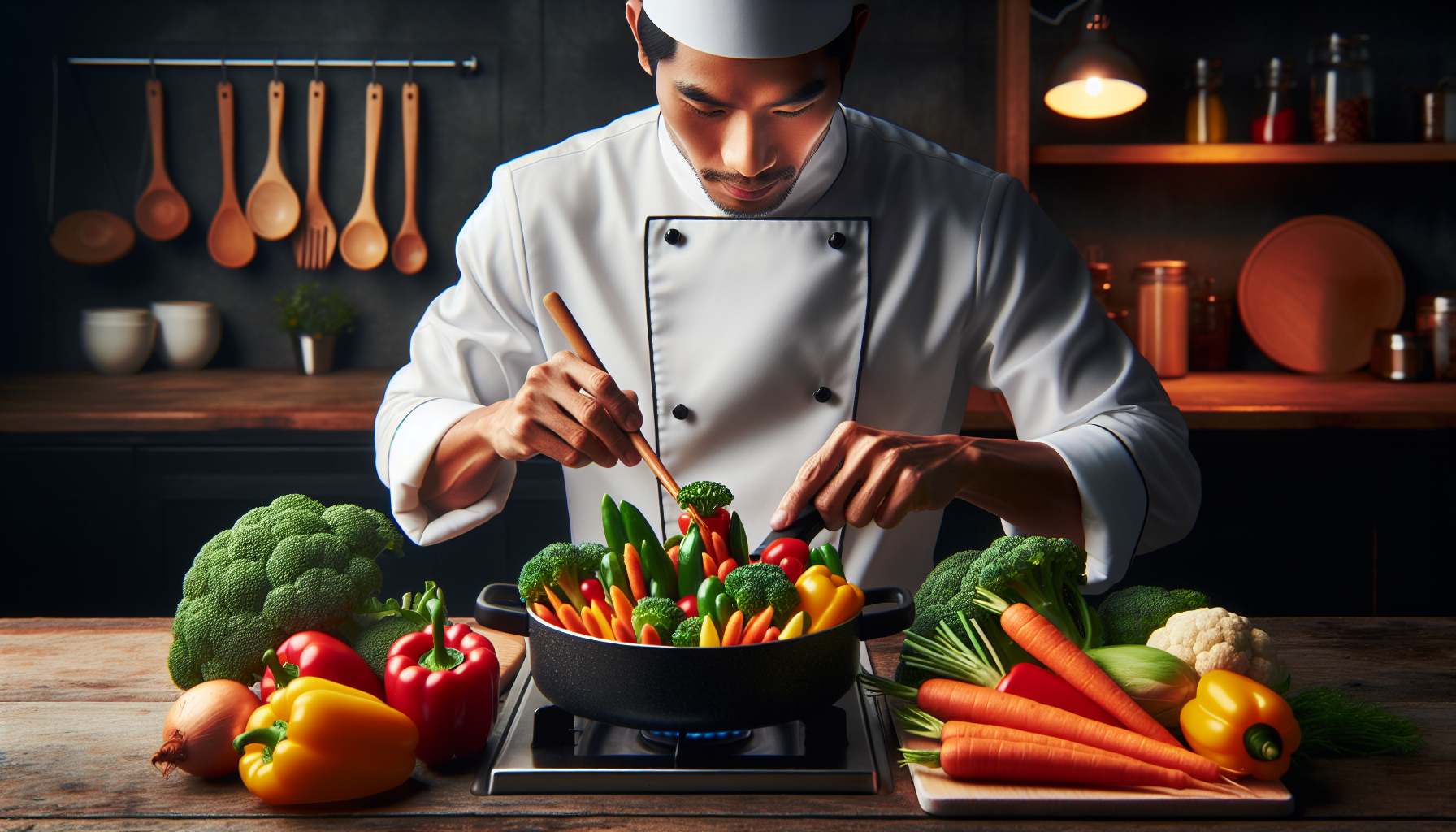Are you tired of always having leftover vegetables or struggling to cook the right portion for just yourself? Look no further! In this article, we will explore the best techniques to cook vegetables perfectly for one, ensuring that you can enjoy a healthy and delicious meal without any waste. From sautéing to roasting, we have got you covered with simple yet effective tips that will make your solo cooking experience a breeze. So, let’s dive in and discover how you can become a master in cooking vegetables for one!

Preparing Vegetables
Choosing the Right Vegetables
When it comes to preparing vegetables, it all starts with selecting the right ones. Look for fresh vegetables that are in season, as they will have the best flavor and texture. Choose vegetables that are firm, with vibrant colors and no signs of wilting or decay. Consider your personal preferences and dietary needs, and opt for a variety of vegetables to ensure a balanced and nutritious diet.
Washing and Cleaning the Vegetables
Before you start preparing the vegetables, it is essential to wash and clean them thoroughly. Rinse the vegetables under cold running water to remove any dirt or debris. Use a vegetable brush for hard-skinned vegetables like potatoes or carrots to remove any stubborn dirt. For leafy greens, separate the leaves and soak them in a bowl of cold water to remove any dirt or sand. Gently pat the vegetables dry with a clean kitchen towel or paper towels before moving on to the next step.
Cutting and Chopping Techniques
Dicing
Dicing is a versatile cutting technique that involves cutting vegetables into small, uniform pieces. Start by cutting the vegetable into slices of the desired thickness. Then, stack the slices and cut them into strips. Finally, cut the strips into small cubes. Dicing is commonly used for vegetables like onions, bell peppers, and carrots, and it is perfect for adding texture to stir-fries, salads, and soups.
Slicing
Slicing is the most straightforward cutting technique and is ideal for vegetables that need to be cut into thin, even pieces. Use a sharp knife and a steady hand to slice the vegetable into thin rounds or strips. Sliced vegetables like cucumbers, zucchini, and tomatoes are great for salads, sandwiches, or as a side dish.
Julienne
Julienne cutting involves creating long, thin matchstick-like pieces of vegetables. Start by cutting the vegetable into long, thin strips. Then, stack the strips and cut them into thin matchstick-sized pieces. Julienne cutting is perfect for vegetables like carrots, peppers, or even potatoes when making homemade fries. These thin, uniform pieces cook quickly and are ideal for stir-frying or adding a crunchy element to salads.
Mincing
Mincing is a finely chopping technique that is often used for herbs, garlic, or ginger. Begin by finely chopping the vegetable into small pieces. Then, use a rocking motion with your knife to further finely chop the vegetables until they are almost a paste-like consistency. Mincing vegetables allows their flavors to be evenly distributed throughout a dish and is commonly used in sauces, dressings, or marinades.
Methods of Cooking Vegetables
Boiling
Boiling is a common and straightforward method of cooking vegetables. Start by bringing a pot of water to a rolling boil. Add the vegetables and let them cook until tender. The cooking time may vary depending on the type and size of the vegetable, so it is essential to monitor them regularly. Boiled vegetables are great for soups, stews, or as a simple side dish.
Steaming
Steaming is a gentle cooking method that helps retain the colors, flavors, and nutrients of the vegetables. To steam vegetables, place them in a steamer basket over a pot of boiling water. Cover the pot with a lid and let the steam cook the vegetables until they are tender. Steamed vegetables are a healthy and versatile option that can be enjoyed on their own or incorporated into various dishes.
Sautéing
Sautéing involves cooking vegetables over medium-high heat in a small amount of oil or butter. Start by heating the oil or butter in a skillet or frying pan. Add the vegetables and toss them frequently to evenly cook them and avoid sticking or burning. Sautéed vegetables are quick and flavorful, making them ideal for stir-fries, pasta dishes, or as a side for proteins like fish or chicken.
Roasting
Roasting vegetables is a fantastic way to bring out their natural sweetness and develop a rich, caramelized flavor. To roast vegetables, toss them in oil, salt, and pepper, then spread them out on a baking sheet. Roast in a preheated oven until they are golden brown and tender. Roasted vegetables can be enjoyed as a side dish, added to salads or grain bowls, or even used as a topping for pizza or pasta.
Grilling
Grilling vegetables adds a delicious smoky flavor and a satisfying char. Brush the vegetables with oil and season them with salt and pepper before grilling them over medium-high heat. The cooking time will vary depending on the size of the vegetable and the intensity of the heat. Grilled vegetables are great for adding to sandwiches, wraps, or as a side for grilled meats.
Cooking Times for Different Vegetables
Root Vegetables
Root vegetables like potatoes, carrots, and beets generally take longer to cook due to their dense texture. When boiling, they can take anywhere from 15 to 30 minutes, depending on their size. The roasting time for root vegetables varies as well, ranging from 25 to 45 minutes at an oven temperature of around 400°F (200°C).
Leafy Greens
Leafy greens such as spinach, kale, or Swiss chard cook quickly. When sautéing, they typically wilt within 3 to 5 minutes. For steaming, it usually takes about 5 to 7 minutes. Keep an eye on them, as they can easily overcook and lose their vibrant color and taste.
Cruciferous Vegetables
Cruciferous vegetables like broccoli, cauliflower, and Brussels sprouts require varying cooking times. When boiling, broccoli typically takes around 5 to 7 minutes, while cauliflower may need 7 to 10 minutes. Brussels sprouts usually take around 12 to 15 minutes to become tender. When roasting, allow them to cook for approximately 20 to 25 minutes at a temperature of 400°F (200°C).
Solanaceous Vegetables
Solanaceous vegetables, such as tomatoes, eggplants, and peppers, have different cooking times depending on the method used. When sautéing, peppers and eggplants need around 10 to 12 minutes to become tender, while tomatoes cook quickly in just 2 to 3 minutes. When roasting, peppers and eggplants typically take 30 to 35 minutes, and tomatoes need around 20 minutes at a temperature of 400°F (200°C).
Alliums
Alliums such as onions, garlic, and shallots are often used as a flavor base for many dishes. When sautéing, these vegetables usually take 5 to 7 minutes to become translucent and soft. When roasting, they become beautifully caramelized in around 25 to 30 minutes at a temperature of 375°F (190°C).
Summer Vegetables
Summer vegetables like zucchini, yellow squash, and corn cook relatively quickly. When sautéing, they should be cooked for approximately 5 to 7 minutes until tender but still slightly crisp. For grilling, zucchini and yellow squash typically take 8 to 10 minutes, while corn on the cob cooks in around 10 to 15 minutes.

Flavoring and Seasoning
Herbs and Spices
Herbs and spices can elevate the flavors of cooked vegetables. Experiment with a variety of herbs such as basil, parsley, thyme, or dill—either dried or fresh—to add depth and freshness to your dishes. Spices like cumin, paprika, or curry powder can provide warmth and complexity. Don’t be afraid to try different combinations and adjust the amount of herbs and spices to suit your taste preferences.
Marinades and Dressings
Marinades and dressings are excellent ways to add flavor to cooked vegetables. Create a simple marinade by combining ingredients like olive oil, lemon juice, garlic, and your choice of herbs or spices. Let the vegetables soak in the marinade for at least 30 minutes before grilling or roasting. Dressings made with ingredients like vinegar, Dijon mustard, honey, or soy sauce can be drizzled over steamed or roasted vegetables to enhance their taste.
Tips for Cooking Vegetables Perfectly
Avoid Overcooking
One common mistake when cooking vegetables is overcooking them, which leads to a loss of flavor, texture, and nutrients. To prevent this, avoid boiling vegetables for too long and keep a close eye on their doneness. Overcooking can also result in mushy or overly soft vegetables, so aim for a slightly crisp or al dente texture when possible.
Monitor Doneness
Different vegetables have different cooking times, so it’s crucial to monitor their doneness throughout the cooking process. Keep a close eye on the vegetables to ensure that they are cooked to your desired level of tenderness. Use a fork or knife to check their texture occasionally. If using a recipe as a guide, keep in mind that cooking times can vary depending on the freshness and size of the vegetables.
Season at the Right Time
Seasoning vegetables at the right time is vital for achieving the best flavor. For boiling or steaming, it is best to season the vegetables with salt and pepper before or during the cooking process. When roasting or grilling, toss the vegetables with oil, salt, and pepper before cooking. This allows the seasoning to adhere to the vegetables and enhance their flavor as they cook.
Maintaining Texture
To maintain the texture of vegetables, it is essential to avoid overcrowding the pan or pot while cooking. Overcrowding can lead to steaming instead of proper browning or caramelization. Give the vegetables enough space to cook evenly, allowing them to achieve a desirable texture. Additionally, ensure that the cooking equipment, such as pans or grills, are properly preheated to promote even cooking and enhance texture.
Using High-Quality Cooking Equipment
Investing in high-quality cooking equipment can make a significant difference in the outcome of your vegetable dishes. Quality knives ensure clean and precise cuts, while sturdy pots and pans distribute heat evenly for better cooking results. Non-stick surfaces make sautéing and flipping vegetables more manageable. By using reliable and well-maintained equipment, you can cook vegetables perfectly every time.
Recipes for Single Servings
Roasted Root Vegetables with Herbs
Ingredients:
- 1 small sweet potato
- 1 small beet
- 1 small carrot
- 1 tablespoon olive oil
- 1 teaspoon dried rosemary
- Salt and pepper to taste
Instructions:
- Preheat the oven to 400°F (200°C).
- Wash, peel, and dice the sweet potato, beet, and carrot into uniform pieces.
- Place the diced vegetables on a baking sheet and drizzle with olive oil. Sprinkle with dried rosemary, salt, and pepper.
- Toss the vegetables to evenly coat them with the oil and seasoning.
- Roast in the preheated oven for 25-30 minutes or until the vegetables are tender and lightly browned.
- Serve the roasted root vegetables as a side dish or as a base for a grain bowl or salad.
Stir-Fried Broccoli with Garlic
Ingredients:
- 1 cup broccoli florets
- 1 tablespoon vegetable oil
- 2 cloves garlic, minced
- 1 tablespoon soy sauce
Instructions:
- Heat the vegetable oil in a skillet or wok over medium-high heat.
- Add the minced garlic and stir-fry for 1-2 minutes until fragrant.
- Add the broccoli florets to the skillet and stir-fry for 3-4 minutes until they are bright green and crisp-tender.
- Drizzle the soy sauce over the broccoli and continue to stir-fry for an additional 1-2 minutes.
- Remove from heat and serve the stir-fried broccoli as a side dish or as a topping for rice or noodles.
Grilled Zucchini and Eggplant Salad
Ingredients:
- 1 small zucchini
- 1 small eggplant
- 1 tablespoon olive oil
- Juice of 1 lemon
- 2 tablespoons chopped fresh basil
- Salt and pepper to taste
Instructions:
- Preheat a grill or grill pan to medium-high heat.
- Cut the zucchini and eggplant into thin slices or long strips.
- Brush the zucchini and eggplant slices with olive oil and season with salt and pepper.
- Grill the vegetables for 2-3 minutes per side or until they are tender and grill marks appear.
- Remove the grilled vegetables from the heat and let them cool slightly.
- In a separate bowl, whisk together the lemon juice, olive oil, chopped basil, salt, and pepper to make a dressing.
- Arrange the grilled zucchini and eggplant on a platter and drizzle with the dressing.
- Serve the grilled zucchini and eggplant salad as a light lunch or as a side dish for grilled meats or fish.
Storage and Leftovers
Proper Storage Techniques
Store unused vegetables in the refrigerator to maintain their freshness and extend their shelf life. For leafy greens, wrap them in a damp paper towel and place them in a plastic bag to keep them crisp. Root vegetables like carrots and beets can be stored in a perforated plastic bag in the crisper drawer. It is essential to remove any rubber bands or ties that may cause moisture retention.
Reheating Tips
When reheating cooked vegetables, it is best to use methods that preserve their texture and flavor. Steaming or sautéing in a small amount of oil or butter can help revive the vegetables without making them soggy. In the microwave, add a tablespoon of water or broth and cover the dish to steam them gently. For roasted or grilled vegetables, consider reheating them in the oven or toaster oven to regain their crispiness.
Benefits of Cooking Vegetables for One
Portion Control
Cooking vegetables for one allows you to have better control over portion sizes. When cooking for yourself, you can prepare just the right amount of vegetables, minimizing food waste and helping you maintain a healthy balance in your meals. This ensures that you eat a reasonable amount of vegetables without feeling overwhelmed or obligated to finish large portions.
Nutritional Balance
By cooking vegetables for one, you have the opportunity to create a well-balanced and nutritious meal tailored to your specific dietary needs. You can choose a variety of vegetables that provide different vitamins, minerals, and antioxidants, ensuring that you receive a wide range of nutritional benefits. Moreover, you can experiment with different cooking methods and flavors to make your vegetables more appealing and enjoyable.
Variety and Creativity
Cooking vegetables for one encourages you to explore different vegetables and try new recipes. With no limitations or preferences to accommodate, you can experiment with unique combinations, techniques, and flavors. This allows you to unleash your creativity in the kitchen and make each meal an exciting and enjoyable experience.
Conclusion
Preparing vegetables can be a rewarding and satisfying experience, especially when done perfectly for one. By choosing the right vegetables, employing various cutting and chopping techniques, and utilizing different cooking methods, you can enhance the flavors, textures, and overall enjoyment of your vegetable dishes. Remember to keep an eye on cooking times, season at the right time, and maintain the desired texture to elevate your vegetable creations. With a bit of practice and the right recipes, you can easily cook vegetables perfectly for one, leading to healthier, more flavorful meals that you will love. So, go ahead and immerse yourself in the wonderful world of vegetable cooking – your taste buds and your body will thank you!
